#ancient mutant fossil turtles
Explore tagged Tumblr posts
Text
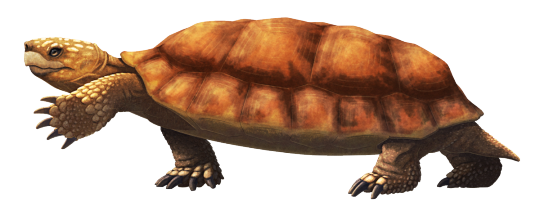
Jiangxichelys neimongolensis was a terrestrial turtle that was part of an extinct group known as nanhsiungchelyids, whose closest living relatives today are the aquatic softshell turtles.
(This species was previously known as "Zangerlia” neimongolensis, but has since been moved into the genus Jiangxichelys instead.)
It lived towards the end of the Cretaceous, about 75-71 million years ago, in what is now the Gobi Desert – which at the time was more of a semi-arid climate with both rivers and sand dunes.
Its 60cm long (~2') carapace had a long wide shape that made it appear rather flattened from the front, but not to quite as much an extreme as its larger American cousin Basilemys.
Several fairly well-preserved specimens have been found that appear to have been buried alive, probably either engulfed by sudden sandstorms or trapped in collapsing burrows. This has preserved some anatomical details previously unknown in nanhsiungchelyids, such as the pattern of scales on top of the head and the presence of large bony osteoderms on the underside of the front toes, which may have aided with traction on loose sandy ground.
———
NixIllustration.com | Tumblr | Patreon
References:
Brinkman, Donald, and Jiang-Hua Peng. "A new species of Zangerlia (Testudines: Nanhsiungchelyidae) from the Upper Cretaceous redbeds at Bayan Mandahu, Inner Mongolia, and the relationships of the genus." Canadian Journal of Earth Sciences 33.4 (1996): 526-540. https://doi.org/10.1139/e96-041
Brinkman, Donald B., et al. "New exceptionally well-preserved specimens of “Zangerlia” neimongolensis from Bayan Mandahu, Inner Mongolia, and their taxonomic significance." Comptes Rendus Palevol 14.6-7 (2015): 577-587. https://doi.org/10.1016/j.crpv.2014.12.005
Jerzykiewicz, T., et al. "Djadokhta Formation correlative strata in Chinese Inner Mongolia: an overview of the stratigraphy, sedimentary geology, and paleontology and comparisons with the type locality in the pre-Altai Gobi." Canadian Journal of Earth Sciences 30.10 (1993): 2180-2195. https://doi.org/10.1139/e93-190
Tong, Haiyan, and Lu Li. "A revision of the holotype of Nanhsiungchelys wuchingensis, Ye, 1966 (Testudines: Cryptodira: Trionychoidae: Nanhsiungchelyidae)." Cretaceous Research 95 (2019): 151-163. https://doi.org/10.1016/j.cretres.2018.11.003
Tong, Haiyan, et al. "New material of Jiangxichelys ganzhouensis Tong & Mo, 2010 (Testudines: Cryptodira: Nanhsiungchelyidae) and its phylogenetic and palaeogeographical implications." Geological Magazine 154.3 (2017): 456-464. https://doi.org/10.1017/S0016756816000108
Wikipedia contributors. “Nanhsiungchelyidae.” Wikipedia, 19 Nov. 2023, https://en.wikipedia.org/wiki/Nanhsiungchelyidae
#science illustration#paleontology#paleoart#palaeoblr#jiangxichelys#zangerlia#nanhsiungchelyidae#cryptodira#turtle#testudines#pantestudines#reptile#art#ancient mutant fossil turtles#turtle power
177 notes
·
View notes
Note
I fricking love your dark au just hooked me like a fish out of the water. And it's got me thinking how would all the dark Bois react if say reader was dino mutant ? Like since In the show a garden guy touched a plant and got mutated would that mean maybe touching ancient fossils do the same ? Can be any dino you want :). Ps wishing you nothing but good days and vibes remember to take breaks ,eat and drink water also sleep! Don't pull a Donnie
Okay! So, I made the reader a Siamosaurus which is this (yeah, it's related to the Spinosaurus)! you don't have to keep the colors, make them whatever u want!!!
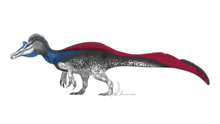
~~~~~~~~~~~~~~~~~~~~~~~~~~~~~~~~~~~~~~~
Similar to the Bat reader who is endangered, a Dinosaur reader would get Draxum's attention, except intensified 200x
Now, you’re a lot more dangerous than other mutants, Draxum realizes this.
Sending all four turtles probably wouldn’t be too effective, so he hired five foot clan members to help the turtles
When the turtles find you, they hesitate for a minute
YOU. ARE. MASSIVE.
You’re at least 7 ft tall, 8-inch talons, large, serrated teeth that look like they would make quick work of cracking a turtle's shell
The turtles and foot clan warriors attacked you quickly, they weren’t fools, having all of them attack you unsuspecting would definitely work in their favor.
However, what they didn’t expect is for you to bolt to the river and hide in it
Even if turtles are decent swimmers, they would be out of their element by whole-ass MAGNITUDES.
The minute a foot clan wades in the water is when you strike, similar to an Alligator or Crocodile, you crush them between your jaws and drag them deeper into the water, the only remains that there ever was a foot clan member was blood tainting the water red
Everyone hesitates, none of them want to go into the water, it was a death sentence, they weren’t the sharpest other than Donnie, but they weren’t stupid either
Donnie switches through his Bo staff, turning into a tranquilizer gun, however, he doesn’t have bait
Looking over at the foot clan members, he makes an executive decision, grabbing one of them and tossing them into the river, causing you to strike at them
Donnie takes aim and shoots you with the tranq dart, causing you to thrash wildly
Donnie signaled Raph to muzzle you with rope, which he quickly did, struggling a bit due to your thrashing
You ended up succumbing to the Tranquilizer a few seconds later, passing out
Waking up later was wild, there was this giant goat bastard who looks like he was trying to badly cosplay as Baphomet.
Growling at him, you flared the feathers on your head, trying to get up but feeling resistance, your neck, muzzle, and tail were secured with metal restraints
He seemed to scoff, the two gargoyles on his shoulders seemed to stare at you in disbelief.
“You are an odd specimen, I knew the Mutagen would mutate people into plants, but never extinct creatures!” you snarled at his words, thinking about all the ways you would mutilate and dismember this fucker
He walked around you before stopping, you glared at him, before he jabbed you with a syringe, you started thrashing, attempting to get out of the restraints, even if it was just your tail that was freed, you would see it as a win
Luckily your legs and arms weren’t restrained, so you forced yourself up, causing your neck restraint to creak before it broke off at the bolts, Draxum stepped back in shock, marveling at your strength
You were able to slip your muzzle restraint off, due to it not being tight, allowing you to open your mouth a bit, the only thing that made it so you couldn’t slip out of the muzzle and thrash your head around was the neck restraint, you snapped over to your tail restraint and bit it off
Getting up, you eyed Draxum up and down, He, seeming to understand the dire situation that was unfolding, started summoning those weird pink vines to capture you again, you were quicker though, bolting off and running out of his lair
Running right back into those four turtles.
They looked at you for a second, as if trying to verify that you were real and snapped into an attack position
You snarled at them, looking at your options, you were surrounded by two sides, however, the water around Draxum’s lair seemed to be a decent way out, you breathed in deeply and jumped into the deep water, swimming down into the watery abyss, the water was warm, but not boiling.
Draxum, Leo, Donnie, Mikey, and Raph looked into the water before Donnie made his usual smartass comment
“I am NOT going into the water to get that thing back” Draxum nodded, he was told about how deadly you were in the water, how you singlehandedly took out two high rank foot clan members before Donnie subdued you.
“Find him later, then” Draxum replied bluntly, before walking back into his Laboratory ~~~~~~~~~~~~~~~~~~~~~~~~~~~~~ Not my finest work but I tried ;v;
#rottmnt x reader#rottmnt#rottmnt headcanons#Dark! ROTTMNT AU#Fae Being a Dumbass#Chaotic Goblin Fae#donatello#raphael#michelangelo#leonardo#baron draxum#the foot clan
186 notes
·
View notes
Photo
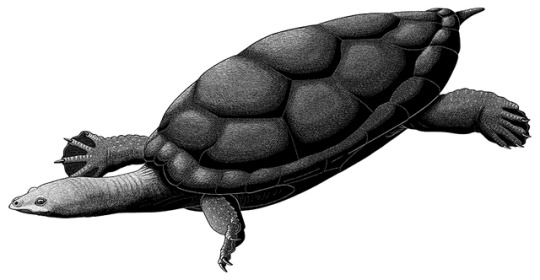
Bothremydids were an extinct group of side-necked turtles that existed from the late Cretaceous to the early Miocene, between about 100 and 20 million years ago. Found across most of the world (with the exception of Antarctica and Australia) they were a diverse group occupying a range of ecological niches, inhabiting both freshwater and near-shore marine habitats.
Although their fossils are mainly just fragmentary remains like pieces of shell, Chupacabrachelys complexus here is actually known from a fairly complete skeleton.
Living in what is now western Texas, USA, during the late Cretaceous (~75 mya), it was an average-sized member of the group at around 1m long (3'3") and was probably marine, swimming around in the shallow tropical waters of the Western Interior Seaway.
It had a particularly unusual skull for a turtle, narrow and triangular and slightly flattened, with elongated eye sockets. The paleontologists who described Chupacabrachelys thought the overall shape was vaguely reminiscent of a canid, and so that ended up inspiring its name — a reference to the mangy coyotes that are occasionally mistaken for the mythical chupacabra.
———
Tumblr | Pillowfort | Twitter | Patreon
#science illustration#paleontology#paleoart#palaeoblr#inktober#chupacabrachelys#bothremydidae#pleurodira#testudines#turtle#testudinata#pantestudines#marine reptiles#art#digital scratchboard#ancient mutant fossil turtles#turtle power
118 notes
·
View notes
Photo
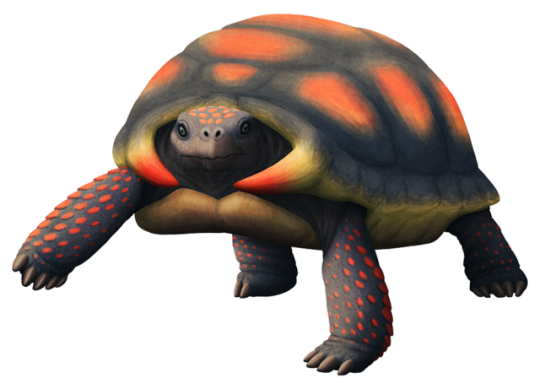
Anomalochelys angulata, a terrestrial turtle from the mid-Cretaceous of Hokkaido, Japan (~100-94 mya).
Measuring around 60cm long (2′), it had a pair of large forward-facing horn-like spikes at the front of its shell -- the function of which isn’t clear, but they may have been useful for defense if it was incapable of fully retracting its head into its shell.
It was part of a family of turtles from Asia and North America known as nanhsiungchelyids, a group that adapted to live fully on land and ended up convergently closely resembling modern tortoises. Other members of this group included the larger Nanhsiungchelys (which was also recently found to have possessed “horns” on its shell!) and the very flat Basilemys.
They were also a rare example of a turtle family that didn’t survive through the end-Cretaceous mass extinction, with no known remains from the Cenozoic.
#basically the cretaceous equivalent of a roomba with two knives taped to it#science illustration#paleontology#paleoart#palaeoblr#anomalochelys#nanhsiungchelyidae#cryptodira#testudines#turtle#testudinata#pantestudines#art#ancient mutant fossil turtles#turtle power
174 notes
·
View notes
Photo

Almost-Living Fossils Month #20 -- Some Very Spiky Turtles
The meiolaniformes were a group of terrestrial turtles that first appeared in the fossil record in the Early Cretaceous, around 125 million years ago. Although they were originally thought to be cryptodirans, more recent studies suggest they weren’t actually quite true turtles at all, instead being close evolutionary cousins to them in a much older and more “primitive” lineage that may go back as far as the Triassic.
They’re known mainly from South America and Oceania, but they may have had a more global distribution during the Cretaceous, with some fossils from the northern continents sometimes being classified as members of the group. However, only the South American meiolaniformes seem to have actually survived through the end-Cretaceous extinction.
The most distinctive meiolaniformes were the heavily armored meiolaniids, which first appeared in Patagonia during the Early Eocene (~48 mya). With large horns on their heads and thorn-like spikes along their long tails, they seem to have convergently evolved to fill the same sort of large-herbivore-tank niche as ankylosaurs and glyptodonts.
They also had fairly large nasal cavities, which might indicate a well-developed sense of smell -- or may have been an adaptation for regulating the heat and moisture content of each breath, similar to the complex noses of ankylosaurs.
The South American meiolaniformes all went extinct around the end of the Eocene (~33 mya), but some meiolaniids had already dispersed across to Australia via Antarctica (before the continents had fully separated, and before Antarctica had frozen over) and they continued to survive there for most of the rest of the Cenozoic. They even went on to spread to various islands around Oceania, suggesting they were able to float and swim like modern giant tortoises.
The largest Australian meiolaniids reached sizes of around 2.5m long (8′2″), making them some of the biggest of all known terrestrial turtles. These giant forms went extinct in the Late Pleistocene, around 50,000 years ago, alongside much of the other Australian megafauna.
A few smaller varieties hung on in smaller islands to the east, with one of the latest-surviving species being Meiolania platyceps on Lord Howe island. It was only about half the size of its biggest Australian relatives -- an example of insular dwarfism -- and lived into the Late Holocene just 3000-2000 years ago.
Meiolania species on other islands seem to have gone extinct after the arrival of humans. But Lord Howe Island appears to have never been inhabited prior to European settlement in the late 1700s, so it’s unclear why this last of the meiolaniformes disappeared.
[Edit: A new study of Meiolania platyceps’ anatomy suggests it may have been more aquatic than previously thought. It might have been something like a giant herbivorous snapping turtle or an armored reptilian hippo, bottom-walking around in coastal lagoons, with its big nasal cavity housing salt glands.]
#almost living fossils month#science illustration#paleontology#paleoart#palaeoblr#meiolania#meiolaniidae#meiolaniformes#testudinata#pantestudines#turtle#stem-turtle#archosauromorpha#reptile#art#ancient mutant fossil turtles#turtle power
331 notes
·
View notes
Photo
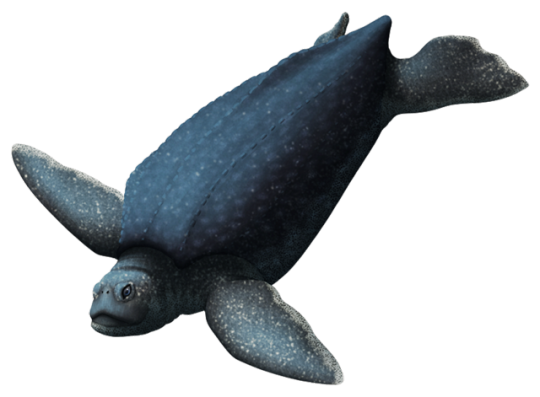
Alienochelys selloumi, a sea turtle from the Late Cretaceous of Morocco (70-66 mya). Although only known from a single skull, it was probably around 2-2.5m long (6′6″- 8′2″), and was closely related to both the modern leatherback turtle and the giant Archelon -- and so it wouldn’t have had a solid shell but instead a leathery skin-covered carapace.
But that one skull was also incredibly weird. While most turtles have pointed beaks, Alienochelys had a blunt squared-off face, sort of “pug-nosed”, with its nostrils set high up between its eyes. It seems to have been specialized for crushing hard-shelled prey between the wide flat grinding surfaces of its beak, more similar to the jaws of rays than those of other turtles.
It also lived alongside another bizarre-jawed turtle, but that’s a subject for another time.
#science illustration#paleontology#paleoart#palaeoblr#alienochelys#dermocheloidae#sea turtle#leatherback turtle#cryptodira#testudines#turtle#pantestudines#marine reptiles#art#ancient mutant fossil turtles#turtle power#i was saving some weird turtles for a potential theme month#but now i know it's one of the less popular options they're into the regular schedule
253 notes
·
View notes